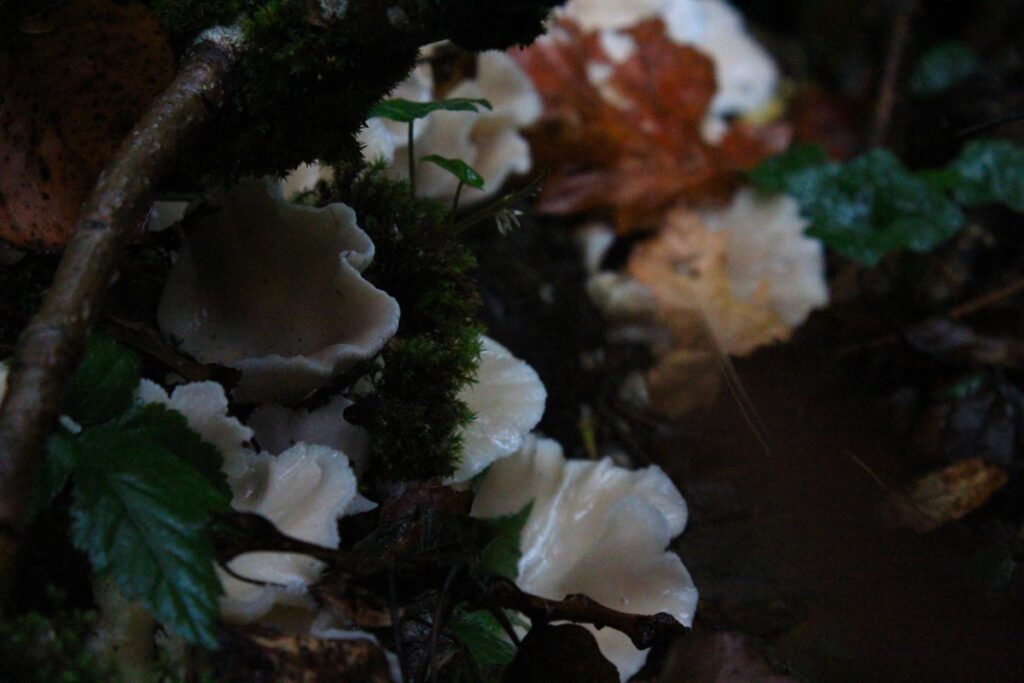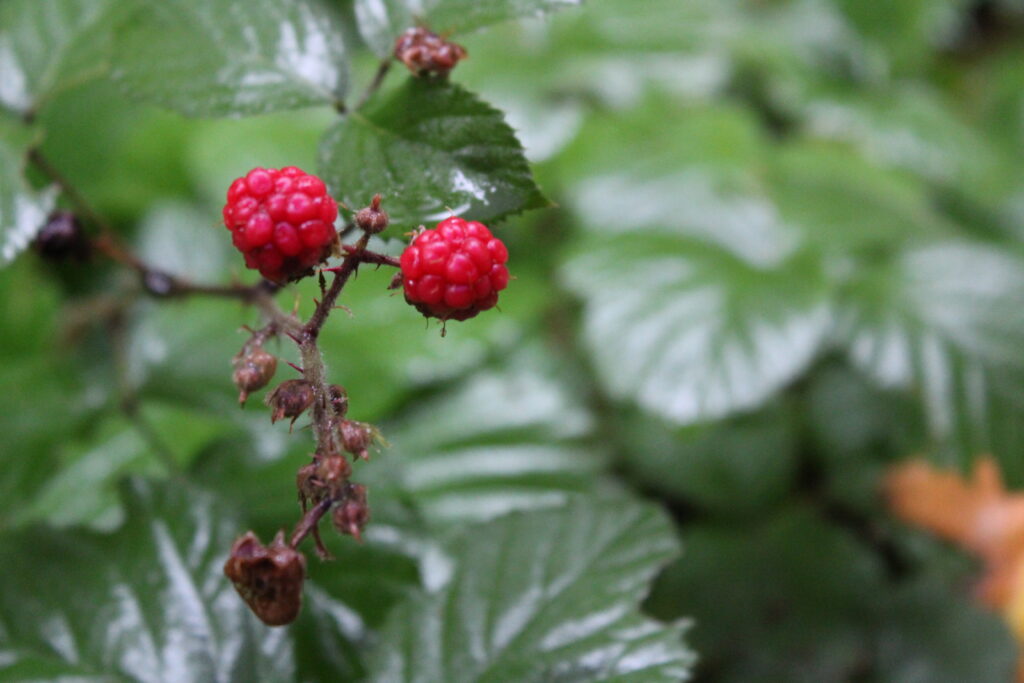Oregon is an incredibly biodiverse state, with more than 3,600 native plant species, climates ranging from coastal rainforests to dry sand dunes and precipitation that makes it possible for flora from all over the world to thrive. Portland is home to only a sliver of Oregon’s impressive biome, and Lewis & Clark is home to even less.
As students attending one of the most beautiful college campuses in the United States—#4 according to The Princeton Review—we walk through a beautiful array of thriving greenery on a daily basis. We anticipate the smell of lavender and rosemary wafting through the air on rainy days, stain our hands and lips purple with blackberries every August, await early autumn’s ripe persimmons and forage for mushrooms as the rainy season settles in. An already lush campus landscape is diversified by the gardeners and the beekeepers of the community, who plant flowers, fruits and vegetables, help keep bees alive and healthy and tend to the soil and the harvests year round.
Unfortunately, well-intentioned students often misjudge the abundance of certain plants, and unknowingly overharvest herbs and other vegetation. Unethical harvesting, both on campus and within our larger community, puts our native ecosystems, plants and even sometimes ourselves,in jeopardy. Our campus and the greater Portland area deserve to be treated with respect, knowledge and consideration.
Harvesting from the wild requires a certain level of commitment and study. Before taking any native plant from its ecosystem, you should not only know how to positively identify the plant, but also understand its role in the ecosystem, its life cycle how scarce it is, overall and locally, how long it will take to recover the part that you took from it, what other living things use and need the plant, and where you can and cannot harvest.
The Native Plant Society of Oregon (NPSO) provides detailed information about Oregon’s regulations regarding harvesting and foraging. Never collect native plants in city, county, state or national parks, including our lovely Tryon State Natural Area across the street from campus. Small scale collecting of common—not rare or endangered native species—is permitted on public lands, such as national and state forests, BLM land (Bureau of Land Management, which maintains public lands throughout the U.S.,) and public roadsides. Ask before harvesting from any private property that is not your own.
Do what you can to get rid of invasive species: Join local invasive plant eradication efforts, prioritize planting native species in your own garden, avoid buying and spreading poorly labeled mixtures of seeds and learn to identify local invasive species. In Portland, some of the most invasive species include Japanese knotweed, English ivy, Irish Ivy, Himalayan blackberry, pokewood and butterfly bush. The Portland.gov website is a well-researched resource that encourages locals to remove these plants when possible, delineating which species may be poisonous and how best to remove each type of invasive plant. Harvesting and uprooting invasive species helps protect the native ecosystems, prevents them from climbing and killing trees, unclogs waterways and creates space for the establishment of native vegetation.
Some environmental conservation organizations recommend only ever harvesting one third of a plant at any given time in order to ensure quick growth and long-term sustainability. The NPSO recommends that people follow the “1-in-20 rule,” which suggests only harvesting one plant after finding 20 others, and not harvesting more than 5 percent, or one twentieth of each plant, its seeds, a patch of moss or a clump of fern fronds.
This rule would greatly benefit our beautiful campus. The lavender, rosemary, yarrow and dandelion on campus have grown sparse as a result of uninformed overharvesting. With more than enough lavender to go around, the root of the issue lies in overharvesting. It’s important to be mindful of the community’s overall need as well as each plant’s growth rate when harvesting. For example, plants like lavender are slower growing, whereas rosemary, once established, grows at a moderate pace. Harvesting certain types of moss and lichen can instantaneously undo years of growth, and cutting off large portions of vegetable or herb plants can inhibit the speed of their growth significantly.
Harvest and forage seasonally: Gather and make use of crops before they begin to wilt or go bad, collect fruits and vegetables when they are ripe or in full bloom and don’t harvest too much from weak baby plants. Let the seasons and the environment guide you in interacting with and taking from the outdoors.
Know whether a plant or fungus is edible, or if it is internally or externally poisonous. Confirm through a book, knowledgeable person or app before consuming something that was harvested or foraged. Plant.id and Book of Mushrooms are both good apps for identifying species and staying informed of poisonous look-alikes.
Some of the most common edible plants in the Portland area are Himalayan blackberry, Japanese knotweed, mint, dandelion, lemon balm, nettles, wakame seaweed, Queen Anne’s Lace (beverages) and bull thistle (cook spines until soft). Remember to wash all plants before preparing them. Learning to dry fresh herbs, make syrups and jams out of local fruits and experiment with new cooking endeavors can save money, support the local vegetation and make use of otherwise unused or unappreciated plants. Composting, reusing vegetable scraps and storing food properly helps prevent food waste and give back to the environment.
“A Natural History Guide to the Lewis and Clark College Campus” is a good resource for learning more about LC- and Tryon-specific ecosystems. Understanding who occupied our land before colonizers laid claim to it, knowing how the land has been treated throughout history, taking the time to learn about the natural biodiversity and thinking conscientiously about how you interact in nature all actively play a role in the preservation and improvement of our natural habitats.
Harvesting and foraging are activities that have the potential to help humans live sustainably and make use of natural resources. It can be incredibly fulfilling and well worth it to learn the basics of your surrounding area. That being said, there is an ethical aspect to our relationship with nature, which entails responsible use and treatment of vegetation and reflecting upon our ecological footprint and how our way of life alters the world around us.
Littering, excessively picking flowers, walking off trail and wasting food are all choices we make. Choose wisely and thoughtfully, and do not be afraid to explore and engage with the natural world around you. Each considerate human being who takes it upon themselves to share what they know and learn what they do not will make a positive impact.
Subscribe to the Mossy Log Newsletter
Stay up to date with the goings-on at Lewis & Clark! Get the top stories or your favorite section delivered to your inbox whenever we release a new issue.




Leave a Reply